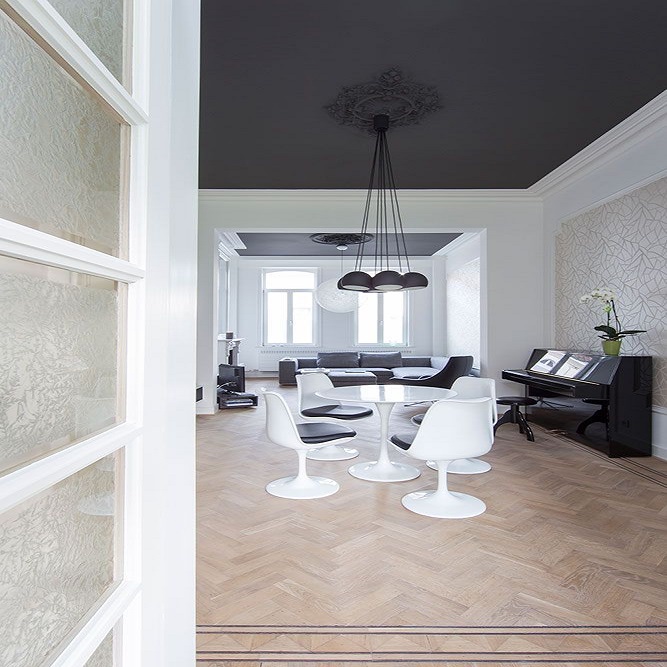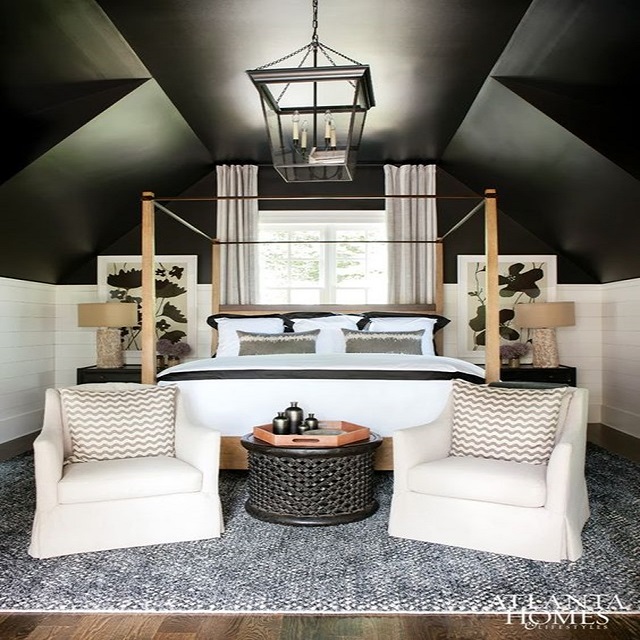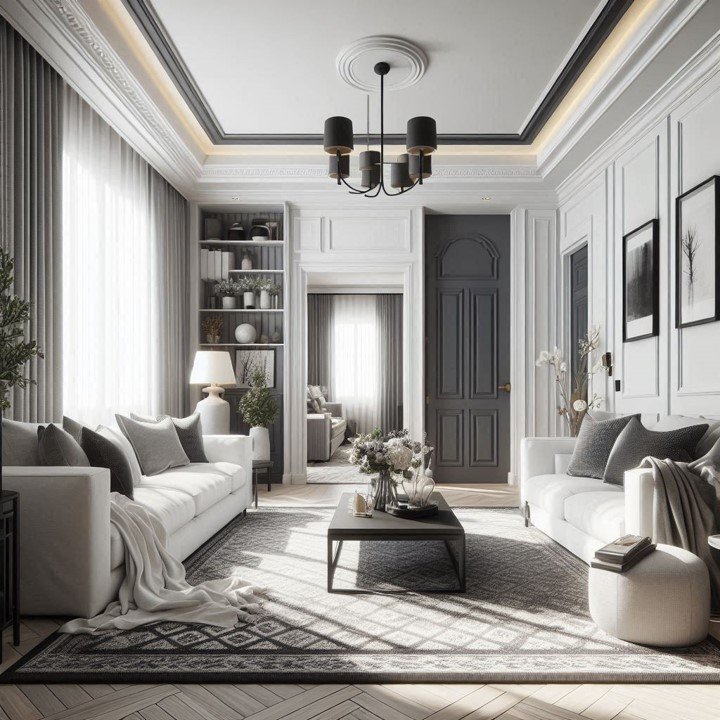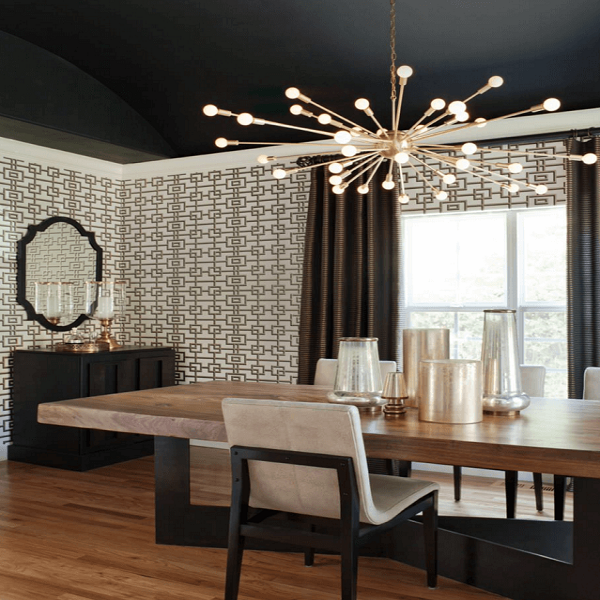Introduction to Dark Ceilings with Light Walls
Dark ceiling light walls – Transitioning from the bygone accent wall trend, dark ceilings paired with light walls are the new dramatists of interior design. This daring pairing creates a visual interest that’s both bold and transformative, challenging the often-overlooked ‘fifth wall’ of a room by delighting it with a dark hue. While light walls maintain an airy feel, their dark counterparts bring depth and sophistication, making for dynamic and stylish interiors.
The Growing Trend in Interior Design
The movement towards dark ceilings is a reflection of modern design’s embrace of boldness and individuality. It represents a departure from traditional white ceilings, offering a fresh way to infuse personality into a space. Interior designers are increasingly employing this technique to craft atmospheres ranging from cozy and intimate to expansive and dramatic. By tapping into the allure of dark hues overhead, homeowners can create stunning visual narratives that speak volumes about their style preferences and design daringness.
The Impact of Dark Ceilings in Different Room Sizes and Types
Dark ceilings can transform a room’s appearance, but their impact varies with room size and type.
Enhancing Tall and Large Spaces with Dark Ceilings
In spacious rooms with high ceilings, dark paint can add intimacy and warmth. This color choice makes large spaces feel cozier, enhancing their aesthetic without making them feel cramped. It works especially well in spaces with significant height, as the dark hue lowers the perceived ceiling height, making the room feel less imposing. Moreover, in large rooms, a dark ceiling can highlight architectural elements like cornice work or beams, enhancing their visual impact.
Considerations for Smaller Rooms with Dark Ceilings
However, in smaller rooms, choosing a dark ceiling requires careful consideration. Dark colors can make these spaces feel tighter and more enclosed. If the room is already limited in size or has low ceilings, a dark ceiling might contribute to a claustrophobic atmosphere. To counter this effect, it’s important to balance the dark ceiling with lighter wall colors and adequate lighting. This approach helps maintain a sense of spaciousness. For really small areas, such as a study or small bedroom, maintaining light or neutral tones on the ceiling might be a better choice to keep the room feeling open and airy.
The Visual Effects of Dark Ceilings
Dark ceilings have a powerful visual impact on interior spaces. The choice of ceiling color can significantly affect a room’s mood and atmosphere. By opting for a dark ceiling, homeowners can craft a distinctive and immersive environment.
Creating Mood and Atmosphere with Ceiling Colors
Choosing the right colors for a ceiling can transform a room’s ambiance. Darker shades bring a sense of drama and sophistication to a space. They also add depth, making ceilings appear lower and rooms more intimate. This is ideal for creating a cozy or majestic setting. For example, dark blue might evoke the tranquility of a night sky, while deep charcoal could lend a room a modern, upscale feel.
How Contrast Can Define Space and Features
The interplay between dark ceilings and light walls defines and shapes a room. This contrast draws the eye, creating a focus on the ceiling’s height and architectural details. It can make crown molding or other ceiling features stand out as focal points. In open-plan areas, dark ceilings can delineate spaces, making them feel distinct even within a larger room. The right contrast can turn an ordinary room into one with character and visual interest.
 Color Selection Strategies
Color Selection Strategies
Choosing the right colors for your dark ceiling and light walls is vital to achieving the desired effect in a room. The perfect pairings can enhance the drama and mood, or can create a balanced, harmonious space. Here are some strategies to help you select the best colors for your dark ceiling and light walls design.
Pairing Dark Ceilings with Suitable Wall Colors
When picking wall colors to complement a dark ceiling, light and neutral hues often work best. They counterbalance the heaviness of the dark ceiling, maintaining a room’s airy feel. For a sophisticated look, consider shades like soft gray, warm beige, or gentle blues. These colors allow the ceiling to stand out while keeping the walls understated and classy.
In rooms with ample natural light, you can opt for slightly darker wall colors to keep the space grounded without it becoming oppressive. Colors such as light taupe or pastel tones can add depth while supporting the bold ceiling.
Monochromatic and Contrast Color Schemes
Monochromatic schemes involve varying shades of a single color, creating a seamless transition between the walls and ceiling. For instance, pairing a rich navy ceiling with lighter blue walls can achieve an elegant and cohesive look. This technique can also make a room feel larger since the lack of contrast doesn’t break up the space visually.
Conversely, choosing contrasting colors can produce a striking visual. Imagine a deep charcoal ceiling paired with crisp white walls – the contrast is bold and eye-catching. This works particularly well in rooms with high ceilings or where you want to highlight molding or other decorative features. Just remember, the key to successful contrast is balance, so it’s important not to let either shade dominate too much.
Application Techniques for Dark Ceilings
When embracing the dark ceiling light walls trend, application techniques are key to creating the desired effect. Different methods can impact the overall look and feel of a room, so it’s important to consider both the aesthetic and practical aspects of painting a ceiling dark.
Color Drenching for a Cohesive Look
Color drenching involves saturating a space in a single color for a unified, harmonious atmosphere. To achieve this with dark ceilings, extend the same dark color from the ceiling onto the walls. This approach not only enhances the coziness but also gives the room an edgy, immersive quality. Think of it as wrapping the room in a velvety darkness that can make a bold statement or serve as a dramatic backdrop for your decor.
Highlighting Architectural Ceilings Details with Dark Paint
Dark paint can bring attention to the unique architectural elements of a ceiling. Whether it’s the intricacies of crown molding, the rustic charm of wooden beams, or a stunning chandelier, a dark ceiling can frame and accentuate these features. Apply a dark hue strategically to these details, and watch as they come to the forefront, creating layers and depth within your design scheme.
For rooms that boast such details, a dark ceiling is an ideal choice to showcase their beauty and craftsmanship. Always remember, though, to balance the dark with lighter walls and proper lighting to ensure the space remains welcoming and not overwhelming.
Potential Drawbacks of Dark Ceilings
While dark ceilings with light walls can add drama and style, there are potential drawbacks.
Feeling of Constriction in Smaller or Low-Lit Rooms
In smaller spaces, a dark ceiling might make the room feel cramped. Rooms with little light can seem even darker. To avoid this, ensure enough light sources to balance the dark ceiling. Light-colored decor can also help lighten the space.
Balancing Color to Avoid Overwhelming Interiors
A dark ceiling needs careful color balancing. Too much dark color can overwhelm the room. Use lighter shades on walls and floors to create contrast. This keeps the space from feeling too heavy or closed in. Accessories in bright colors can add bursts of energy to the space.
 Conclusion
Conclusion
The trend of combining dark ceilings with light walls has taken center stage in the world of interior design. This bold approach offers a unique way to add depth, drama, and a touch of sophistication to any space. However, it’s not without its challenges, particularly in terms of the size and lighting of the room.
Summary of Benefits and Challenges with Dark Ceilings
Embedding a dark ceiling in your design can yield remarkable benefits. A dark ceiling can:
- Create an intimate atmosphere in large rooms with high ceilings.
- Frame and enhance architectural details, drawing the eye upward.
- Provide a striking contrast to light walls, adding visual interest and definition.
Despite these advantages, it’s vital to consider the potential downsides. Dark ceilings may:
- Make small or poorly-lit rooms feel more confined and less inviting.
- Require careful balance with wall colors and lighting to prevent a room from feeling too dark or heavy.
- Challenge one’s comfort level with bold design choices, which may not appeal to everyone.
Dark ceilings paired with light walls are a modern drama that can create stunning results when done right. By considering room size, lighting, and color harmony, you can harness the power of this design trend to its fullest potential.



